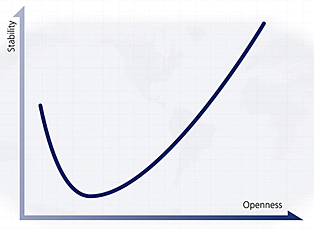The J Curve
 | |
| Author | Ian Bremmer |
|---|---|
| Language | English |
| Genre | Politics, International Affairs |
| Publisher | Simon and Schuster |
Publication date | April 12, 2006 |
| Publication place | United States |
| Media type | Hardback |
| Pages | 320 p. (hardback edition) |
| ISBN | ISBN 0-7432-7471-7 Parameter error in {{ISBNT}}: invalid character |
The J Curve: A New Way to Understand Why Nations Rise and Fall (Simon and Schuster: 2006) is a book by political scientist Ian Bremmer.
Bremmer's J Curve describes the relationship between a country's openness and its stability; focusing on the notion that while many countries are stable because they are open (the United States, France, Japan), others are stable because they are closed (North Korea, Cuba, Iraq under Saddam Hussein). According to Bremmer, a government's motivations differ dramatically depending on where they fall on the J curve.

The J Curve model

The x-axis of the political J-Curve graph measures the 'openness' (of freedom) of the State in question and the y-axis measures the stability of that same state. It suggests that those states that are 'closed'/undemocratic/unfree (such as the Communist dictatorships of China and Cuba) are very stable; however, as one progresses right, along the x-axis, it is evident that stability (for relatively short period of time in the lengthy life of nations) decreases, creating a dip in the graph, until beginning to pick up again as the 'openness' of a state increases; at the other end of the graph to closed states are the open states of the West, such as the United States of America or the United Kingdom. Thus, a J-shaped curve is formed.
States can travel both forward (right) and backwards (left) along this J-curve, and so stability and openness are never secure. The J is steeper on the left hand side, as it is easier for a leader in a failed state to create stability by closing the country than to build a civil society and establish accountable institutions; the curve is higher on the far right than left because states that prevail in opening their societies (Eastern Europe, for example) ultimately become more stable than authoritarian regimes.
Bremmer's entire curve can shift up or down depending on economic resources available to the government in question. So Saudi Arabia's relative stability at every point along the curve rises or falls depending on the price of oil; China's curve analogously depends on the country's economic growth.
It is this J-Curve theory that provides advocates of wars in the Middle East (Iraq and Afghanistan, for example) with support to continue distributing democracy in these regions, as although such States are, at present, 'unstable', they are progressing along the J-Curve and shall eventually be free of the 'dip' in the curve, resulting in them being 'open'/free and stable - the ultimate aims of all civilised societies. But in the absence of sustained international commitment in such states, the long path up the right of the curve is impossible, leading instead to civil war or a return to the authoritarian past.
Quotes by the Author
- "The developed world should neither shelter nor militarily destabilize authoritarian regimes—unless those regimes represent an imminent threat to the national security of other states. Developed states should instead work to create the conditions most favorable for a closed regime’s safe passage through the least stable segment of the J curve—however and whenever the slide toward instability comes. And developed states should minimize the risk these states pose the rest of the world as their transition toward modernity begins."
References
- Ian Bremmer (2006). The J Curve: A New Way to Understand Why Nations Rise and Fall. Simon and Schuster. ISBN 0-7432-7471-7.
External links
- Official website
- J Curve on The Daily Show with Jon Stewart
- The J Curve on BBC Newsnight Bookclub
- J Curve in the Washington Post
- J Curve in US News and World Report
- J Curve in the London Times
- The J Curve in the Daily Telegraph
Reviews
- The Geometry of Geopolitics. Review in The Economist. August 31, 2006.
- Graphing the World, by Michael Freedman. Review in Forbes. September 15, 2006.
- Curve an Effective Tool in US Foreign Policy, by Cecil Johnson. Review in The Boston Globe. October 1, 2006.
- Looking at the World Through Shape of a J, by Tim Worstall. Review in The Philadelphia Inquirer. September 3, 2006.
- Dangerous Curve Ahead, by James Steinberg. Review in Austin American-Statesman. September 24, 2006.
